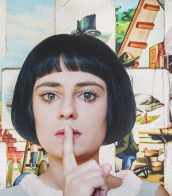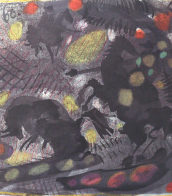super 8 ilm



Joseph Heinrich Beuys was a German artist, renowned for his significant contributions to the realms of sculpture, painting, and installation art, which have left a lasting impact on the culture and art world. His work transcended traditional boundaries, merging art with social theory and politics, thus redefining the role of the artist in society. Beuys's unique approach to materials, incorporating substances like fat and felt, symbolized healing and insulation, reflecting his broader philosophical and ecological concerns.
Beuys's art was deeply influenced by his experiences during World War II and his academic background in natural sciences and sculpture. His concept of "social sculpture" proposed that art could transform society, emphasizing creativity as a fundamental component of human existence. This vision led him to use his performances, or "actions," as a medium to communicate his ideas, making him a pivotal figure in the Fluxus movement. Notable works such as "How to Explain Pictures to a Dead Hare" and "7000 Oaks" exemplify his innovative use of performance and environmental art to engage and challenge the public.
His legacy is preserved in major museums and galleries worldwide, including the Museum of Modern Art in New York and the Tate Modern in London. These institutions house key pieces that exemplify Beuys's diverse artistic output, from his early drawings and sculptures to his later installations and public interventions. His influence extends beyond the art world, impacting environmental activism and educational reform, underscoring his belief in the transformative power of art.
For collectors and experts in art and antiques, Joseph Heinrich Beuys remains a figure of immense interest, not only for his groundbreaking artworks but also for his profound impact on contemporary art theory and practice. To stay informed about new product sales and auction events related to Beuys, we invite you to sign up for updates. This subscription ensures you are always in the loop regarding opportunities to engage with the enduring legacy of one of the most influential artists of the 20th century.


Joseph Heinrich Beuys was a German artist, renowned for his significant contributions to the realms of sculpture, painting, and installation art, which have left a lasting impact on the culture and art world. His work transcended traditional boundaries, merging art with social theory and politics, thus redefining the role of the artist in society. Beuys's unique approach to materials, incorporating substances like fat and felt, symbolized healing and insulation, reflecting his broader philosophical and ecological concerns.
Beuys's art was deeply influenced by his experiences during World War II and his academic background in natural sciences and sculpture. His concept of "social sculpture" proposed that art could transform society, emphasizing creativity as a fundamental component of human existence. This vision led him to use his performances, or "actions," as a medium to communicate his ideas, making him a pivotal figure in the Fluxus movement. Notable works such as "How to Explain Pictures to a Dead Hare" and "7000 Oaks" exemplify his innovative use of performance and environmental art to engage and challenge the public.
His legacy is preserved in major museums and galleries worldwide, including the Museum of Modern Art in New York and the Tate Modern in London. These institutions house key pieces that exemplify Beuys's diverse artistic output, from his early drawings and sculptures to his later installations and public interventions. His influence extends beyond the art world, impacting environmental activism and educational reform, underscoring his belief in the transformative power of art.
For collectors and experts in art and antiques, Joseph Heinrich Beuys remains a figure of immense interest, not only for his groundbreaking artworks but also for his profound impact on contemporary art theory and practice. To stay informed about new product sales and auction events related to Beuys, we invite you to sign up for updates. This subscription ensures you are always in the loop regarding opportunities to engage with the enduring legacy of one of the most influential artists of the 20th century.


Ulla von Brandenburg is a German media artist and scenographer living and working in Paris.
Ulla studied scenography in Germany at the University of Art and Design Karlsruhe and fine arts at the University of Fine Arts Hamburg. Her projects are realized through a combination of black and white film, installation, performance, drawing and painting, mural painting, theater and video.
Theater is central to the artist's work. She often draws on representational forms from the late nineteenth century and early modernism. Ulla von Brandenburg expresses her love of fabrics and draperies in the creation of peculiar curtains with obvious references to classical theater productions, themes of Harlequin and buffoonery.


Man Ray, born Emmanuel Radnitzky, was an American visual artist who played a significant role in the Dada and Surrealist movements. His pioneering efforts in photography, alongside his work in painting and sculpture, have cemented his place as a major figure in modern art. Known for his innovative techniques and the ability to convey complex ideas through simple, striking visuals, Man Ray's contribution to the art world is profound.
Throughout his career, Man Ray was celebrated for his avant-garde approach and his ability to transcend traditional boundaries between different artistic mediums. His photography, characterized by experimental techniques such as solarization and rayographs (cameraless photographs), challenged conventional perceptions of photography as merely a means of representation. These artistic innovations made him a central figure in both Parisian and American art circles.
Man Ray's works are housed in some of the world's most prestigious museums and galleries, including the Museum of Modern Art in New York and the Centre Pompidou in Paris. His pieces, such as "Le Violon d'Ingres" and "Noire et Blanche," are iconic images that continue to influence artists today. His ability to blend the abstract with the realistic, and the humorous with the serious, has left a lasting legacy in the world of art.
For collectors and experts in art and antiques, the work of Man Ray offers a glimpse into the revolutionary changes that shaped the visual arts in the 20th century. His unique perspective and pioneering techniques continue to inspire and challenge those interested in the boundaries of creativity and expression.
If you're passionate about the avant-garde, or simply wish to explore the fascinating world of Man Ray further, sign up for our updates. You'll receive alerts on new product sales and auction events related to Man Ray, ensuring you never miss an opportunity to engage with the legacy of this extraordinary artist.


Joseph Fernand Henri Léger was a French artist renowned for his innovative approach to Cubism and his transition towards a figurative, populist style. Born in Argentan, Orne, Lower Normandy, Léger's early career was marked by a stint as an architectural draftsman and a series of educational pursuits that eventually led him to Paris, where he embraced painting seriously. His artistic journey was significantly influenced by the bold abstractions of Cubism, characterized by geometric shapes and a vibrant palette, distinguishing his work from his contemporaries with what came to be known as "Tubism".
Léger's service in World War I profoundly impacted his artistic direction, leading him to adopt a 'mechanical' style that depicted the modern industrial world with sleek, tubular forms. This period saw creations like "Soldier with a Pipe" and "The Card Players," reflecting his war experiences and the mechanical aesthetics of the time. The post-war era encouraged Léger to explore the mechanical style further, evident in works like "The Bargeman" and "Mechanical Elements," highlighting the pace of technological advancement.
Throughout his career, Léger's work evolved, notably in the 1920s, where he aligned with Purist ideas, blending classicism with modernity. This phase is exemplified in "Woman with a Cat," showcasing a classical form with a modern, polished finish. By the 1930s, Léger's art took a more figurative, populist turn, aiming to democratize contemporary art and make it more accessible. His commitment to art education, especially for the common worker, underscored his belief in the social role of art.
For those intrigued by Joseph Fernand Henri Léger's groundbreaking contributions to modern art, his works can be found in prestigious museums worldwide. His legacy continues to inspire art collectors and enthusiasts alike. To stay updated on exhibitions and auction events featuring Léger's work, sign up for updates and embrace the unique opportunity to explore the richness of his artistic endeavors.


Ed (Edward Francis) Paschke was an American artist celebrated for his confrontational and vibrant paintings. Born on June 22, 1939, in Chicago, Illinois, Paschke found inspiration in comic strips and the work of Burne Hogarth, the creator of the Tarzan comic. His early fascination with visual storytelling translated into a unique art style that combined elements of pop culture, often in a sexualized or grotesque manner.
Paschke's art journey began at the School of the Art Institute of Chicago, where he honed his skills in draftsmanship. However, he struggled with abstract and Expressionist painting, the dominant styles of the 1950s. His career took a notable turn in 1961 when he started working as an illustrator for Playboy magazine, a position he held until 1989. This experience, coupled with a brief stint working in a mental institution, significantly influenced his art, particularly his theme of portraying society's marginalized figures.
Throughout his career, Paschke's work evolved in both style and medium. In his early paintings, he reimagined legendary figures in unusual contexts, like setting Marilyn Monroe's head atop an accordion player's body in "Pink Lady" (1970), or reinterpreting Claudette Colbert as a tattooed lady in "Painted Lady" (1971). His later works, such as "Matinee" (1987), showcased a shift towards electronic media, with images disintegrating into electronic disturbances. This evolution in his art reflected a deeper exploration of American values' underside—fame, violence, sex, and money—a theme he shared with Andy Warhol, one of his major influences.
Paschke's innovative technique involved using an overhead projector to layer images, which he then meticulously rendered in oil paints. He started with a black and white underpainting, followed by layers of colored glazing or impasto, creating vibrant, neon-colored finishes. This process paralleled the historical transition from black-and-white to color in printing, film, and television.
Despite his unique approach and contributions to the art world, Paschke remained somewhat distant from the mainstream New York art scene. Nevertheless, his work is celebrated in many museum collections, including the Art Institute of Chicago, the Madison Museum of Contemporary Art, and the Whitney Museum of American Art, among others. His influence extends beyond his lifetime, as seen in the opening of the Ed Paschke Art Center in Chicago in 2014, which commemorates his works alongside other Chicago artists.
Edward Francis Paschke passed away on November 25, 2004, but his legacy continues to inspire and challenge the art world, emphasizing the power of visual media to explore and critique societal norms and values.
For collectors and experts in art and antiques, Paschke's work offers a unique blend of cultural commentary and bold visual experimentation. To stay updated on new product sales and auction events related to Edward Francis Paschke, sign up for our updates. This subscription is a gateway to exploring the fascinating world of Paschke's art and its enduring impact on contemporary culture.


Julian Opie is a visual artist of the New British Sculpture movement.










































































